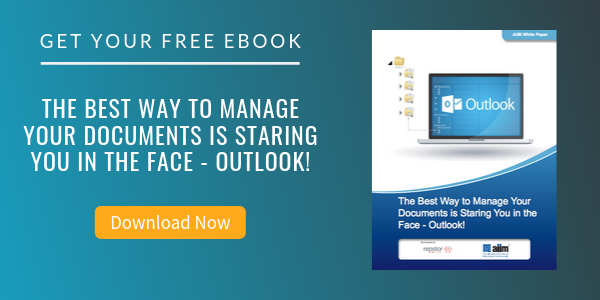
8 Key Email Management Trends
-
Email is a huge and growing time drain.
On average, our respondents spend more than an hour and a half per day processing their emails, with one in five spending three or more hours of their day.
-
The “balkanization” of email control is a real issue.
Over half have hand-held access by phones, Blackberries, and PDAs. Two-thirds process work-related emails out of office hours, with 28% confessing to doing so “after work, on weekends and during vacations.”
-
The growing volume of email is exacerbating management challenges.
“Sheer overload” is reported as the biggest problem with email as a business tool, followed closely by “Finding and recovering past emails” and “Keeping track of actions." The growing volume of email is making it difficult for individuals to manage their inboxes.
-
Organizations lack confidence in email as a means to document commitments.
Over half of respondents are “not confident” or only “slightly confident” that emails related to documenting commitments and obligations made by staff are recorded, complete, and retrievable.
Nearly a third of organizations have a policy that insists on signed paper or faxes for all contractual commitments. If these are scanned and stored for general access as image files, then all well and good. If filed as paper, they are likely to be unavailable to general staff. Twenty percent accept that email attachments may be part of important contractual commitments. Of the remaining, half agree that both attachments and their associated email messages can be important for these contracts, and half are aware that complete email conversations (threads) are likely to be important regarding contractual commitments.
-
Most email management approaches are still tactical.
Only 10% of organizations have completed an enterprise-wide email management initiative, with 20% currently rolling out a project. Even in larger organizations, 17% have no plans to, although the remaining 29% are planning to start sometime in the next two years.
-
Archive vs. back-up is still a major point of confusion.
Some 45% of organizations (including the largest ones) do not have a policy on Outlook “Archive settings,” so most users will likely create .pst archive files on local drives.
There have also been several high profile cases involving the retrieval of emails from back-up tapes. One would expect this to have brought into focus the difference between back-up (restoration of the repository to its state at a given date/time) and archive (able to use selection criteria to find specific emails), but in our survey, 64% of respondents feel that their organization doesn’t understand the difference.
Perhaps one reason for this is that in 20% of organizations, email policy decisions are made by IT with no input from Records Management or Legal. An honest 8% of respondents admit that in their organization, no one makes email policy decisions, and it is completely out of control!
-
No real strategy exists for what to do with emails after they are read.
Only 19% of those surveyed capture important emails to a dedicated email management system or to a general-purpose ECM system. 18% print emails and file as paper, and a worrying 45% file in non-shared personal Outlook folders.
In 45% of organizations, important emails are never moved from the recipients’ personal folders. To this, Outlook adds a further ugly twist. The so-called “Archive” function, largely used to keep down inbox sizes or to avoid fixed-term deletion policies, creates a secondary database - the notorious archive.pst file. The default location for this important repository is on the user’s local hard drive – bad enough as a desktop, but it could as easily be on a laptop. If more than one desktop, or a desktop and a laptop, are used interchangeably, multiple “archives” can easily be created by the unwary, leaving big gaps in the email record.
This scenario can be avoided by setting policies to place archive.pst in a networked and backed up location, but an astonishing 44% of organizations fail to do so, even those with over 5,000 employees.
-
E-discovery remains a huge Achilles heel.
A third of organizations have no policy to deal with legal discovery, 40% would likely have to search back-up tapes, and 23% feel they would have gaps from deleted emails. Only 16% have retention policies that would justify deleted emails.
Over a quarter of organizations would take more than a month to produce documents for a legal discovery process. As regards to the likelihood of being required to produce such evidence, eliminating the don’t knows, 18% had been exposed to a legal challenge in the last 12 months and a further 15% in the last three years – a one-in-three chance overall.
About John Mancini
John Mancini is the President of Content Results, LLC and the Past President of AIIM. He is a well-known author, speaker, and advisor on information management, digital transformation and intelligent automation. John is a frequent keynote speaker and author of more than 30 eBooks on a variety of topics. He can be found on Twitter, LinkedIn and Facebook as jmancini77. Recent keynote topics include: The Stairway to Digital Transformation Navigating Disruptive Waters — 4 Things You Need to Know to Build Your Digital Transformation Strategy Getting Ahead of the Digital Transformation Curve Viewing Information Management Through a New Lens Digital Disruption: 6 Strategies to Avoid Being “Blockbustered” Specialties: Keynote speaker and writer on AI, RPA, intelligent Information Management, Intelligent Automation and Digital Transformation. Consensus-building with Boards to create strategic focus, action, and accountability. Extensive public speaking and public relations work Conversant and experienced in major technology issues and trends. Expert on inbound and content marketing, particularly in an association environment and on the Hubspot platform. John is a Phi Beta Kappa graduate of the College of William and Mary, and holds an M.A. in Public Policy from the Woodrow Wilson School at Princeton University.



